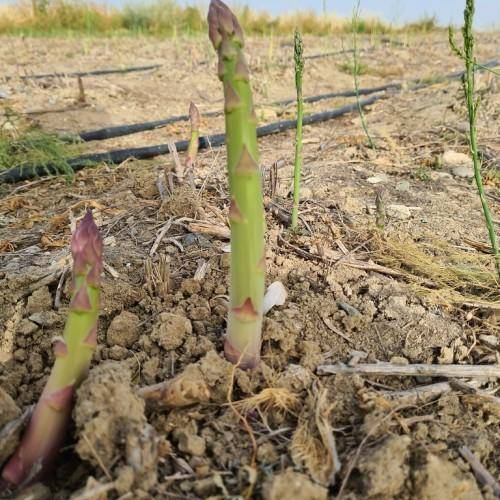
asparagus
Asparagus officinalis
Cycle:
Herbaceous Perennial
Watering:
Average
Hardiness Zone:
3 - 10
Flowers:
Flowers
Sun:
Full sun
Fruits:
Fruits In Summer Ready In Spring
Edible:
Yes
Growth Rate:
High
Maintenance:
Low
Salt Tolerant:
Yes
Care Level:
Medium
watering
Asparagus plants need to be watered about an inch (2.5 cm) per week and more during dry periods. Too much or too little water can cause problems, so water deeply and less often; this encourages the roots to grow deep and increases drought tolerance. Water when the soil surface is dry and water until it begins to drip from the bottom of the pot. It is best to water in the morning so that the leaves have time to dry before nightfall.
sunlight
Asparagus (Asparagus officinalis) needs full sun exposure to grow and develop properly. The best time to provide the most sunlight is during the spring and summer, when the days are longer and the sun is more intense. It should be given at least 6 to 8 hours of direct sunlight each day. If the plant is not receiving enough light, it may become weak and leggy and experience reduced yields of edible shoots.
pruning
For asparagus, pruning should take place once each year within the first few days of spring. Pruning should remove any dead, damaged, or diseased foliage as well as branches or shoots that appear to be struggling. Additionally, any foliage that is overcrowded should be pruned back lightly to allow for good air circulation throughout the plant. After pruning, any excess foliage removed should be disposed of in a compost bin or given to livestock.
Propagation
Season
Hardiness Map
FAQ
Is asparagus classified lilies or onions?
No, asparagus is not classified as either lilies or onions. Asparagus is a vegetable that is a member of the lily family, but it is not a lily itself nor is it an onion. Asparagus is a flowering plant and its edible part is the young shoots. It is high in dietary fiber and is a good source of vitamin A, vitamin C, vitamin E, vitamin K, and other vitamins and minerals.
Do asparagus plants not to be overwatered?
Yes, asparagus plants should not be overwatered. When planted outdoors, they should only receive enough water to keep the soil moist, but not soggy. If planted indoors, they should be watered when the soil is dry to the touch and the water should not be left to pool in the container or saucer. Overwatering asparagus plants can cause root rot and fungal diseases that can damage the plants.
Can I cultivate asparagus plant in a xeriscaping garden?
Yes, you can cultivate asparagus plant in a xeriscaping garden. Asparagus is a hardy, drought-tolerant plant that can survive well in low-water gardens. To successfully grow asparagus in a xeriscaping garden, the soil should be nutritiously rich with a slightly acidic pH. Choose a spot that gets full sun and provide your asparagus bed with a generous amount of mulch to retain moisture. Asparagus requires a deep, moderately moist soil—deep enough for the roots to grow. Provide your bed with regular watering, but do not over-water. Asparagus produces edible spears in its second season so if you plan to grow asparagus in your xeriscaping garden, be prepared to be patient.
Can asparagus be growing as a cover crop?
Yes, asparagus can be grown as a cover crop. As a cover crop, asparagus is non-invasive and nitrogen-fixing. It can be planted in cool climates starting in late winter and provides a living mulch with dense foliage that can be harvested throughout the season. It also helps protect the soil and provide erosion control, and it can be mowed or tilled in at the end of the season to return nutrients to the soil. Asparagus can even be intercropped with other vegetables, helping to increase yields and prevent disease.
Should I remove any wild asparagus plants from my garden?
Removing wild asparagus plants from your garden is entirely up to your personal preference. If you want more control over how many plants you have and what plants you have, then you may want to remove any wild asparagus plants. Wild asparagus plants can spread quickly and become difficult to control and manage. If you are okay with that then you may want to leave them in your garden. However, make sure you don't inadvertently dig up the wild asparagus plants and harm them. If you do decide to remove them make sure to do it responsibly so not to obsessively disturb the surrounding environment.
Are there any health benefits of asparagus roots?
Yes, there are numerous health benefits to eating asparagus roots. It is an excellent source of vitamins A, C, K, and B6, as well as minerals like copper, selenium, and iron. It also contains many antioxidants and is a good source of dietary fiber. Asparagus root also contains essential amino acids like lysine, leucine, and tryptophan, which are important for cellular health and energy production. Additionally, Asparagus root may provide potential anti-inflammatory and anti-cancer benefits.
